8th Century Mahabalipuram Shore Temple
The Mahabalipuram Shore Temple is a complex of three shrines dedicated to the Hindu god Shiva, built by the Pallava dynasty in the 8th century AD. It is one of the oldest structural temples in South India and a UNESCO World Heritage Site. The temple is located on the Bay of Bengal coast and is known for its dramatic setting against the backdrop of the crashing waves.
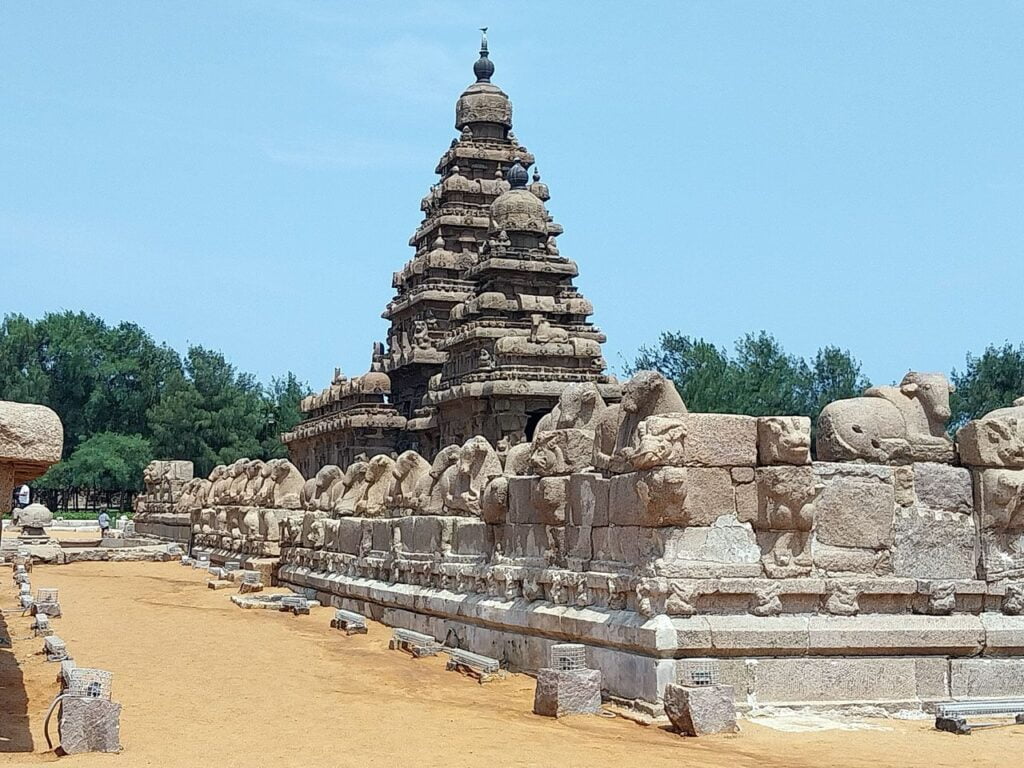
Contents
History of Mahabalipuram Shore Temple:
Mahabalipuram, also known as Mamallapuram, isn’t just a single temple, but rather a collection of ancient monuments dating back to the 7th and 8th centuries CE. Located on the Coromandel Coast of Tamil Nadu, India, this UNESCO World Heritage Site offers a glimpse into the artistic and religious fervor of the Pallava dynasty.
The Pallavas, who ruled the region between the 3rd and 9th centuries, were not only adept at warfare and administration but also passionate patrons of the arts. This is evident in the exquisite rock-cut cave temples, monolithic chariot-shaped shrines (rathas), and intricate open-air reliefs that adorn Mahabalipuram.
Let’s delve into the history of these magnificent structures:
- Early Beginnings: Before the Pallavas arrived, Mahabalipuram was already a thriving port city. However, it was under the reign of Mahendravarman I (600-630 CE) that the city transformed into a major cultural center. Mahendravarman, himself a poet and playwright, commissioned the creation of several cave temples, including the Pancha Rathas and the Adikainar Kavar cave.
- Narasimhavarman I’s Legacy: Mahendravarman’s son, Narasimhavarman I (630-680 CE), also known as Mamalla, continued his father’s artistic pursuits. He is credited with carving the awe-inspiring Descent of the Ganges relief, a massive open-air tableau depicting the descent of the holy river from heaven to earth.
- From Rock to Stone: Narasimhavarman also marked a shift from rock-cut architecture to structural temples. The Shore Temple, a complex of shrines overlooking the Bay of Bengal, stands as a testament to his vision. Completed around 725 AD, the Shore Temple is one of the oldest structural stone temples in South India.
- Beyond Temples: Mahabalipuram’s monuments are not merely architectural marvels; they are also repositories of Hindu mythology and epics. The carvings on the cave walls and reliefs depict stories from the Mahabharata, Ramayana, and other sacred texts, offering a window into the religious beliefs and practices of the Pallava era.
- UNESCO Recognition: In 1984, the Group of Monuments at Mahabalipuram was inscribed as a UNESCO World Heritage Site, acknowledging its outstanding universal value and cultural significance. Today, Mahabalipuram continues to be a popular tourist destination, attracting visitors from around the world who come to marvel at the artistry and devotion embodied in its ancient monuments.
Read More>> Subramanya Swamy Temple Thiruparankunram
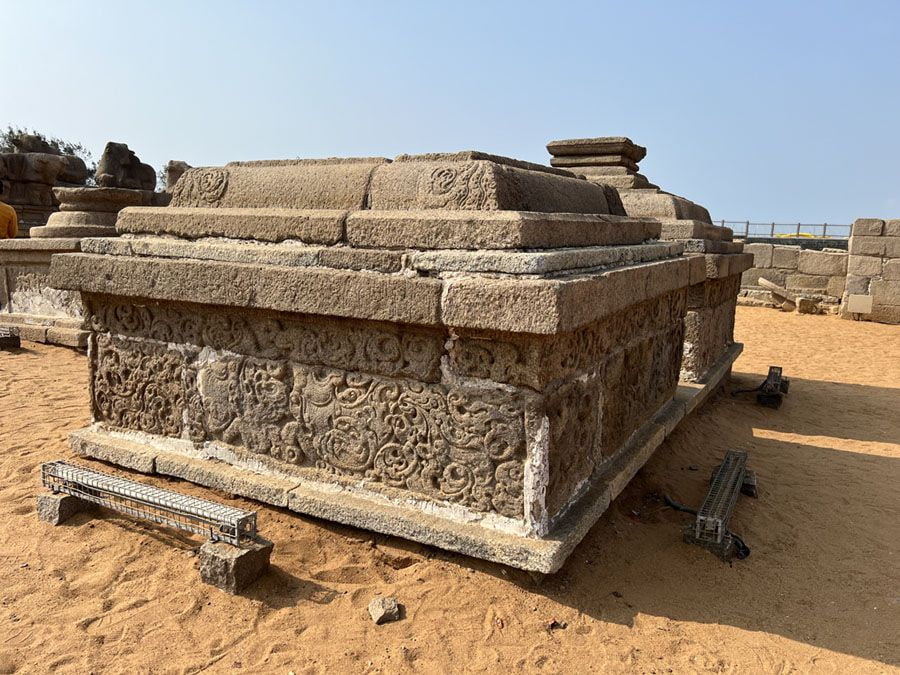
Legend of Mahabalipuram Shore Temple:
One legend, woven into the tapestry of Hinduism, speaks of the Seven Pagodas that once graced the shores. These temples, dedicated to various deities, rose like sentinels against the Bay of Bengal, their spires mirroring the stars in the twilight sky.
The tale begins with Prahlada, a young prince, whose unwavering devotion to Lord Vishnu angered his tyrannical father, Hiranyakasipu. The king, consumed by disbelief, challenged Prahlada’s faith, declaring that Vishnu could not be found where he stood. In a dramatic turn of events, Vishnu emerged from a pillar in the form of Narasimha, a man-lion who slayed the wicked king, upholding the virtues of righteousness.
Bali, Prahlada’s grandson, captivated by the divine intervention, chose the very spot where Narasimha appeared as the site for his kingdom. This city, named Mahabalipuram, meaning “the City of the Great Bali,” blossomed into a center of art, culture, and faith.
However, the jealous eyes of Indra, the king of gods, fell upon Mahabalipuram. Blinded by envy, he unleashed a tempestuous storm that swallowed six of the Seven Pagodas, leaving only the Shore Temple to stand defiant against the raging waves. This solitary survivor, with its intricate carvings and soaring towers, is a testament to the resilience of faith and the enduring power of legend.
While the veracity of the legend remains shrouded in the mists of time, its impact is undeniable. The story of Mahabalipuram is not just about temples; it’s about the triumph of good over evil, the unwavering power of belief, and the eternal dance between creation and destruction.
Read More>> Brihadeeswarar Temple: Timeless Marvel of Chola Architecture
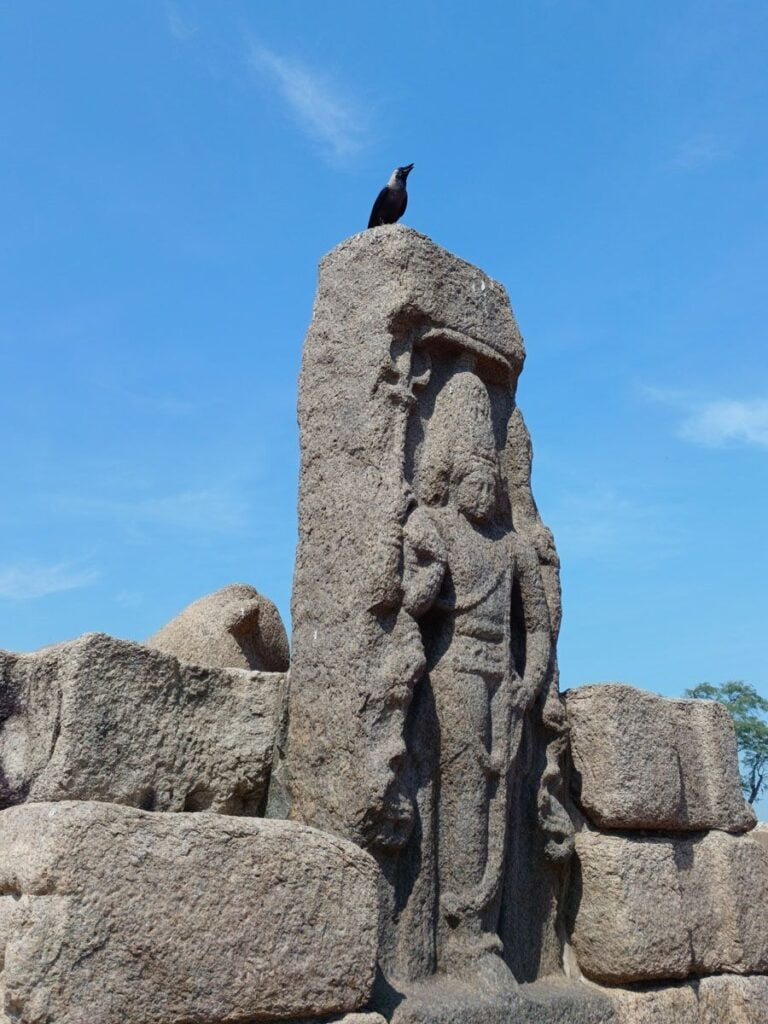
Significance of Mahabalipuram Shore Temple:
Historical Significance:
- Witness to a bygone era: Built primarily during the 7th and 8th centuries AD by the Pallava dynasty, these temples stand as a testament to the artistic and architectural prowess of that era.
- Evolution of temple architecture: Mahabalipuram showcases the transition from rock-cut cave temples to structural temples, marking a crucial turning point in South Indian temple architecture.
- Once a bustling port city: Believed to be a flourishing port city in ancient times, Mahabalipuram’s temples offer insights into the maritime trade and cultural exchange of that period.
Religious Significance:
- Dedicated to Hindu deities: The temples are predominantly dedicated to Hindu gods like Shiva, Vishnu, and Krishna, reflecting the deep religious beliefs of the Pallavas.
- Pilgrimage center: Even today, Mahabalipuram remains a significant pilgrimage destination for Hindus, attracting devotees from far and wide.
- Depiction of Hindu mythology: The intricate carvings and sculptures on the temple walls narrate scenes from Hindu epics like the Mahabharata and Ramayana, serving as a visual representation of these sacred stories.
Artistic and Architectural Significance:
- Exquisite craftsmanship: The temples are renowned for their intricate carvings, sculptures, and bas-reliefs, showcasing the exceptional skills of Pallava artisans.
- Unique Dravidian architecture: Mahabalipuram temples exemplify the Dravidian style of architecture, characterized by towering gopurams (gateways), pyramidal vimana (temple towers), and intricately carved pillars.
- UNESCO World Heritage Site: Recognizing its immense cultural and historical value, UNESCO designated Mahabalipuram as a World Heritage Site in 1984.
Read More>> Arunachaleswara Temple: A Spiritual Experience of a Lifetime
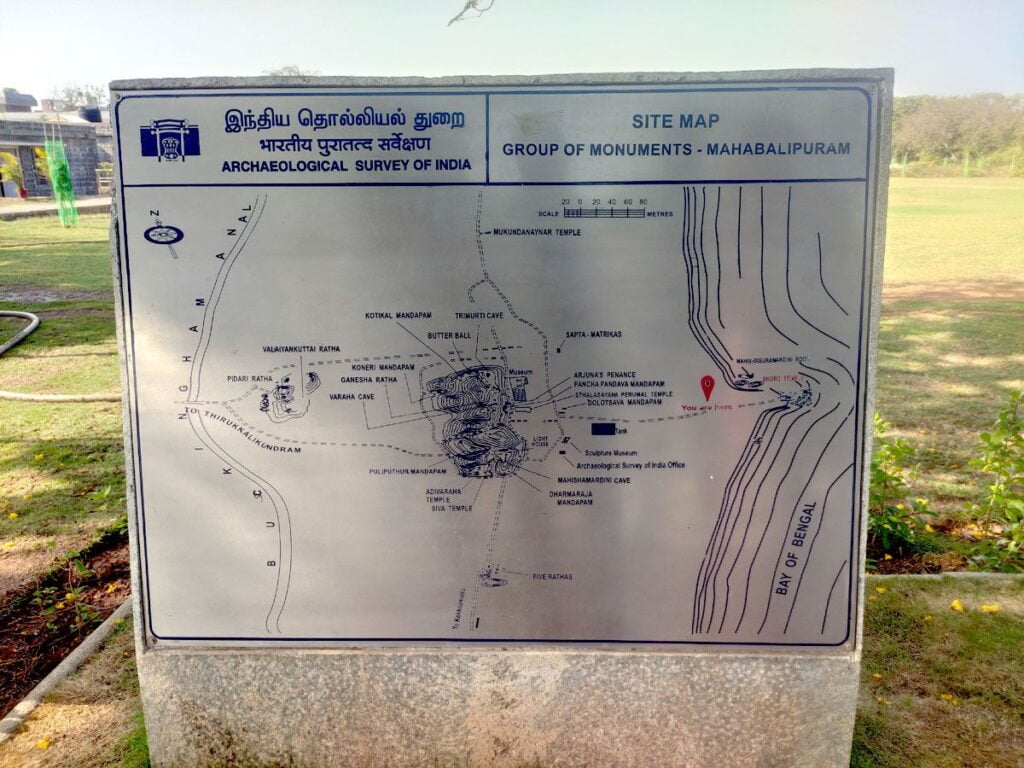
Myths of Mahabalipuram Shore Temple:
1. The Jealous Indra and the Submerged City:
Legend has it that Mahabalipuram was once a sprawling and magnificent city with seven pagodas, each dedicated to a different deity. The most prominent among them was the Shore Temple, standing tall and proud, facing the Bay of Bengal. However, the city’s splendor caught the eye of Indra, the king of the gods, who became envious of its beauty. In a fit of rage, he unleashed a furious storm that swallowed six of the seven pagodas, leaving only the Shore Temple as a lonely sentinel. Some even say that the remaining six temples still lie hidden beneath the waves, waiting to be rediscovered.
2. Arjuna’s Penance and the Descent of the Ganges:
Another myth revolves around Arjuna, one of the Pandava brothers from the epic Mahabharata. It is said that after the Kurukshetra war, Arjuna, burdened by guilt and remorse, sought penance at Mahabalipuram. He shot an arrow into the earth, seeking to bring forth the holy Ganges River to wash away his sins. The mighty ocean parted at the point of impact, revealing a majestic rock-cut relief depicting Arjuna standing on one leg, aiming his arrow towards the sky. This intricate carving, known as “Arjuna’s Penance” or “Descent of the Ganges,” is a testament to the Pallava dynasty’s masterful sculpting skills.
3. The Five Rathas and the Chariot Race:
The Five Rathas, a group of monolithic chariot-shaped shrines carved from massive granite boulders, are another highlight of Mahabalipuram. Each Ratha is dedicated to a different Pandava brother, except for Draupadi. Mythologies say that the Pandavas, known for their chariot skills, once held a grand chariot race at this very spot. The Five Rathas are believed to represent their chariots, frozen in time, forever commemorating their legendary race.
4. The Butterball and Krishna’s Leela:
A giant spherical boulder precariously balanced on a smaller rock base, aptly named the “Butterball,” adds to the mystique of Mahabalipuram. Legend has it that Lord Krishna, known for his playful pranks, placed the massive ball there with a single finger, showcasing his superhuman strength. The Butterball remains a popular tourist attraction, with many attempting to push it over, only to be met with its seemingly immovable stance.
Read More>> Ranganathaswamy Temple Srirangam
Places to visit near Mahabalipuram Shore Temple:
- Chennai: The capital city of Tamil Nadu is just around 60 kilometers north of Mahabalipuram. Chennai offers a mix of historical sites, cultural attractions, and a vibrant urban atmosphere.
- Pondicherry (Puducherry): Located about 100 kilometers south of Mahabalipuram, Pondicherry is known for its French colonial architecture, serene beaches, and a unique blend of Indian and French culture.
- Kanchipuram: Known as the “City of a Thousand Temples,” Kanchipuram is approximately 70 kilometers away from Mahabalipuram. It is a significant pilgrimage site with numerous ancient temples.
- DakshinaChitra: This cultural village, around 25 kilometers from Mahabalipuram, offers a glimpse into the traditional art and craft forms of South India. It’s a great place to learn about the region’s cultural heritage.
- Covelong (Kovalam) Beach: About 20 kilometers from Mahabalipuram, Covelong Beach is known for its serene environment and water activities. It’s a nice place to relax and enjoy the coastal scenery.
- Arignar Anna Zoological Park: Located in Vandalur, Chennai, this zoo is one of the largest in South Asia. It’s about 60 kilometers from Mahabalipuram and makes for a great day trip, especially if you’re traveling with family.
- Tiger Cave: Situated about 5 kilometers before Mahabalipuram, the Tiger Cave is known for its rock-cut architecture and beautiful carvings. It’s worth a visit if you’re interested in ancient structures.
- Thirukalukundram (Thirukazhukundram) Temple: Around 15 kilometers from Mahabalipuram, this temple is dedicated to Lord Vedagiriswarar and is known for its unique setting on a hill.
Read More>> Ekambareswarar Temple: 3500 yr old Mango Tree
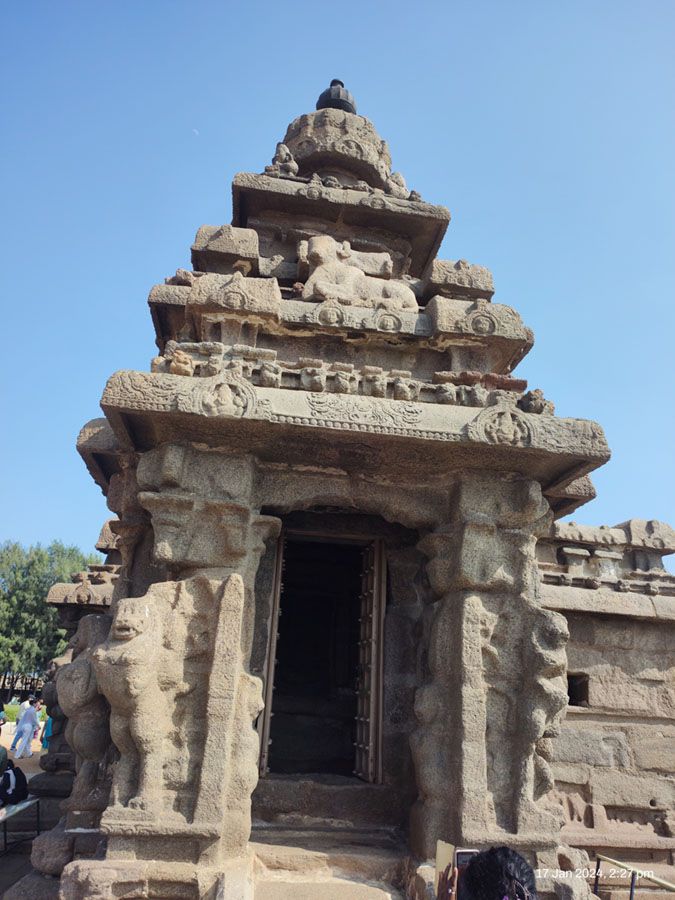
FAQ:
1. What is the Shore Temple?
The Shore Temple is a complex of temples and shrines overlooking the Bay of Bengal in Mahabalipuram, Tamil Nadu, India. It is a UNESCO World Heritage Site and one of the oldest structural (versus rock-cut) stone temples in South India.
2. When was it built?
The Shore Temple was built around the 7th century AD, during the reign of King Narasimhavarman II of the Pallava dynasty.
3. What is it made of?
The temple is built with sculpted granite stones hauled from a nearby quarry.
4. What is the significance of the Shore Temple?
The Shore Temple is significant for several reasons:
- It is a stunning example of Dravidian architecture, characterized by its pyramidal towers, intricate carvings, and vibrant colors.
- It is one of the earliest surviving structural temples in South India and played a key role in the development of Dravidian temple architecture.
- It is a UNESCO World Heritage Site, recognized for its outstanding universal value.
- It is a popular tourist destination, attracting visitors from all over the world with its beauty and historical significance.
5. Can I visit the Shore Temple?
Yes, the Shore Temple is open to the public and is a popular tourist destination.
6. What are the best times to visit?
The best time to visit the Shore Temple is during the cooler months, from October to March. During the monsoon season (July to September), the temple may be closed due to heavy rains and rough seas.
7. Are there any festivals or events at the Shore Temple?
The Shore Temple hosts several festivals throughout the year, including the Mahabalipuram Dance Festival and the Tamil New Year celebrations.
8. What else can I do in Mahabalipuram?
Mahabalipuram is a popular tourist destination with many other attractions, including:
- Arjuna’s Penance, a massive bas-relief sculpture
- Five Rathas, a group of monolithic chariot temples
- Descent of the Ganges, a rock-cut sculpture
- Beaches and water sports
How to reach Mahabalipuram Shore Temple:
By Air: The nearest airport to Mahabalipuram is Chennai International Airport (MAA), which is approximately 58 kilometers away. From the airport, you can hire a taxi or use other transportation options to reach Mahabalipuram.
By Train: The nearest railway station is Chengalpattu Railway Station, which is about 29 kilometers away from Mahabalipuram. From Chengalpattu, you can hire a taxi or take a bus to reach Mahabalipuram.
By Bus: Mahabalipuram is well-connected by road, and there are regular bus services from Chennai and other major cities in Tamil Nadu. State-owned buses and private operators run services to Mahabalipuram. You can also hire a taxi or use other private transportation services.
By Car: You can drive to Mahabalipuram from nearby cities like Chennai. The journey is approximately 1-2 hours, depending on traffic and the route taken. The East Coast Road (ECR) is a scenic route that connects Chennai to Mahabalipuram.

One Comment